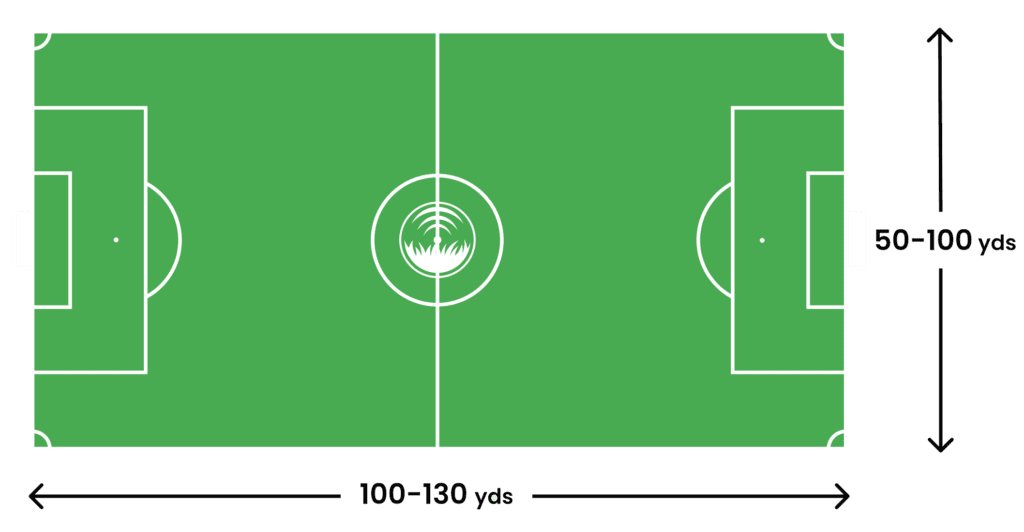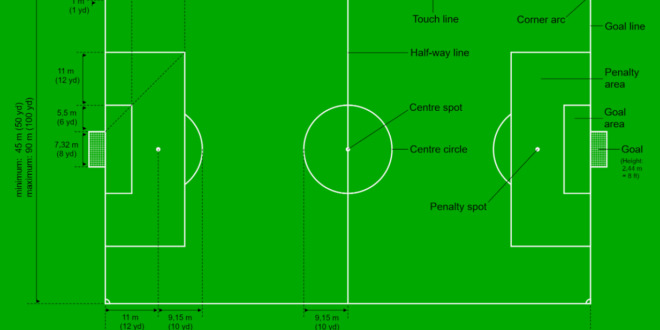A soccer field typically ranges from 50 to 100 yards wide. Official matches often feature fields around 70 to 80 yards wide.
Soccer, known as football outside of North America, is a globally beloved sport characterized by its vast, green playing field. The width of the field, also known as the pitch, plays a critical role in the dynamics of the game.
Governing bodies like FIFA stipulate clear dimensions for fields used in professional play, ensuring a level of consistency for international matches. Amateur and youth leagues might have fields that vary more significantly in size. Whether you’re a player, coach, or avid fan, understanding field dimensions will enhance your appreciation and strategy for the game. Clear standards allow for fair play and determine the pace and style of a soccer match. Soccer field dimensions are integral to the game’s rules and influence the tactics used by teams.
🔴How Wide is a Soccer Field🔴

Table of Contents
Soccer Field Dimensions
Understanding soccer field dimensions is key for players, coaches, and fans alike. A soccer pitch, also known as a soccer field, varies in size, but it must fall within certain measurements set by the sport’s governing bodies. Knowing these regulatory sizes and how they can differ across leagues helps grasp the scope of play.
Regulation Sizes
The rules of soccer, dictated by the International Football Association Board (IFAB), outline specific dimensions for a professional game. The length of a regulation soccer field must be between 100 yards (90 meters) and 130 yards (120 meters). Regarding width, a field should span between 50 yards (45 meters) and 100 yards (90 meters).
| Field Part | Minimum Size | Maximum Size |
|---|---|---|
| Length | 100 yards (90 meters) | 130 yards (120 meters) |
| Width | 50 yards (45 meters) | 100 yards (90 meters) |
Variations Across Leagues
While regulations set the standard, actual soccer field sizes can vary by league and level of play. For instance, youth leagues often play on smaller fields. Professional leagues like the English Premier League or Major League Soccer may choose dimensions that suit their style of play, within regulatory limits.
- The English Premier League: closely follows IFAB regulations.
- Major League Soccer: fields may be wider to suit tactical preferences.
Fields for international matches often stay close to the maximum size to make the game more dynamic and challenging.
Regulatory Bodies And Their Influence
Regulatory bodies considerably shape the dimensions of soccer fields worldwide. These organizations ensure standardization, allowing for fair play and consistency across international games. The influence of these bodies not only guides the construction of new stadiums but also affects the gameplay itself.
Fifa Standards
The International Federation of Association Football (FIFA) sets the global criteria for soccer field dimensions. FIFA stipulates that the touchline (length) must be between 100-110 meters (110-120 yards) and the goal line (width) between 64-75 meters (70-80 yards). The internationally recognized standards ensure that fields remain uniform for professional play.
Uefa And Local Associations
While FIFA sets international standards, the Union of European Football Associations (UEFA) and local soccer associations might enforce additional regulations. They often cater to regional play and tournaments within their jurisdictions. These organizations maintain harmony with FIFA’s requirements while serving the local community’s needs.
Key Measurements
Understanding the dimensions of a soccer field is vital. Coaches, players, and fans alike find value in grasping the key measurements. From local youth leagues to the FIFA World Cup, the sizes can vary. Yet, specific ranges define regulation play.
Length And Width
A soccer field’s size depends on the level of play. Regulation fields fall within specific measurements:
- Length: Ranges from 100 to 130 yards (90-120 meters)
- Width: Ranges from 50 to 100 yards (45-90 meters)
International matches have stricter rules:
- Length: Must be 110 to 120 yards (100-110 meters)
- Width: Must be 70 to 80 yards (64-75 meters)
These dimensions ensure the game remains fair and standardized.
Goal Area And Penalty Area
The goal area and penalty area are critical zones on a soccer field. Both are marked distinctly for clarity:
| Area | Dimensions |
|---|---|
| Goal Area | 6 yards (5.5 meters) from the goalposts, extending 6 yards into the field |
| Penalty Area | 18 yards (16.5 meters) from the goalposts, extending 18 yards into the field |
Penalty spots stand 12 yards (11 meters) from the goal. Understanding these areas helps in strategizing plays.
Factors Affecting Soccer Field Width
Have you ever wondered why soccer fields vary in size? The width of a soccer field does not have a fixed measurement. Different factors influence how wide a field can be. Understanding these factors can give you a clearer picture of the beautiful game.
Stadium Size
The physical space available in a stadium can set the boundaries for a soccer field’s width. Larger stadiums often have wider fields. Smaller venues may need narrower fields to fit within the area. Fields must leave room for player safety and audience visibility.
Level Of Play
The level of play also impacts how wide a field is. Professional leagues like FIFA have strict guidelines. These range from 50 to 100 yards in width. Youth leagues often have smaller fields. This suits their pace and style of play.
| Field Type | Minimum Width | Maximum Width |
|---|---|---|
| Professional | 50 yards | 100 yards |
| Youth | Varies | Less than Professional |
- Professional fields: adhere to FIFA standards.
- Youth fields: size can vary with the league’s rules.
- Field conditions: can lead to adjustments in width.
Markings And Their Significance
The soccer field is more than just a patch of grass—it’s a carefully marked battleground where every line has a reason. Each marking on the field plays a crucial role in the game, guiding players and referees alike. These lines ensure the game is fair and exciting. Below, we’ll explore two of the most essential soccer field markings: the touchlines and the goal lines.
Touchlines
Touchlines define the length of the soccer field. They are the longest lines on either side of the field. When the ball crosses these lines, it’s out of play. The size of the field can vary, but touchlines must always be longer than the goal lines.
- The length of touchlines is between 100 and 110 meters for international matches.
- In non-international matches, they can be between 90 and 120 meters.
Goal Lines
Goal lines are crucial for scoring in soccer. They mark the width of the field and the front of the goal. A goal is only valid if the ball completely crosses this line. The precision of these lines can significantly influence the game’s outcome.
| Field Type | Goal Line Length |
|---|---|
| International Matches | Between 64 and 75 meters |
| Non-International Matches | Between 45 and 90 meters |
It is important to note that the goal area and penalty area are both marked off of the goal lines. These areas impact where goal kicks, penalty kicks, and goalkeeper actions take place.

Comparison With Other Sports
Exploring how wide a soccer field is offers an intriguing look at sports from around the world. Let’s see how soccer compares to other terrace titans like rugby and American football.
Rugby Pitches
Rugby pitches share similarities with soccer fields in terms of shape but differ in dimensions. Here’s how:
- Rugby fields are larger, generally between 68 and 70 meters wide.
- The total playing area, including the end zones, is up to 100 meters long.
- The main play areas exclude the goal areas, which add an extra 6–22 meters on each end.
To illustrate, a table clarifies these numbers:
| Sport | Width | Length (Goal Areas Included) |
|---|---|---|
| Rugby | 68-70m | 100m (plus 6-22m at each end) |
| Soccer | 64-75m | 100-110m |
American Football Fields
Let’s turn our attention to American football fields, which have unique measurements:
- American football fields have a fixed width of 53 1/3 yards (or about 49 meters).
- The total length is 120 yards (110 meters), including two 10-yard end zones.
- Playfields are marked every 5 yards with a distinctive gridiron pattern.
This stands in contrast to soccer fields, whose dimensions can vary within set ranges. Here’s how they compare side-by-side:
| Sport | Width | Length (Goal Areas Included) |
|---|---|---|
| American Football | 49m | 110m |
| Soccer | 64-75m | 100-110m |
While soccer fields are wider, American football fields maintain a consistent grid for strategic play.
Maintenance Practices
Understanding how wide a soccer field is serves as just a starting point. Keeping that field in top shape means regular maintenance. Professionals use various practices to ensure the pitch is always game-ready. Let’s explore some key aspects of soccer field maintenance.
Turf Management
Good turf management keeps the field green and healthy. Teams should follow these steps:
- Mowing: Cut grass to its ideal height.
- Fertilization: Feed the soil to nurture the grass.
- Aeration: Allow air to reach the roots.
- Irrigation: Ensure adequate water reaches the turf.
- Weed Control: Remove unwanted plants regularly.
- Disease Management: Watch for and treat symptoms fast.
A lush field makes games smooth and safe.
Line Marking
Line marking defines the game’s boundaries. Teams must mark lines clearly before each match. Here’s how:
- Measure the field to confirm its size.
- Choose white paint for visibility.
- Use a line marking machine for straight edges.
- Check for consistency in line width.
- Reapply the paint as it fades over time.
Regular upkeep keeps the field in excellent condition, ensuring fair play.
Innovations In Field Design
Today’s soccer fields are not just patches of grass. They are high-tech arenas. Teams and fans see changes every year. Through innovation, fields have become safer and more sustainable. Let’s dive into some groundbreaking changes in soccer field design.
Artificial Turf Advancements
The latest artificial turfs are a game-changer. New materials make them nearly identical to real grass. Players get better grip and cushioning. This reduces injuries. Modern fibers keep the blades upright longer. They require less infill, making fields more eco-friendly too. Here’s what’s new:
- Temperature control technology keeps the surface cool
- Improved drainage systems: no more waterlogged fields
- Soft, non-abrasive surfaces are safer for tackles and dives
Environmentally Friendly Practices
Eco-friendly designs are leading the way. Fields now use systems that conserve water. They also feature materials that are kind to the planet. Solar panels power stadium lights and scoreboards. Rainwater is even collected and reused. This table shows how fields are going green:
| Green Feature | Benefit |
|---|---|
| Recycled Materials for Turf | Reduces waste |
| LED Lighting | Saves energy |
| Organic Infill | Minimizes pollutants |
| Water Conservation Systems | Lowers water use |

Frequently Asked Questions For How Wide Is A Soccer Field
What is the standard width of a soccer field?
The standard width of a soccer field is between 50 and 100 yards (45-90 meters). Regulations stipulate a minimum width of 50 yards and a maximum of 100 yards for international matches.
Does field width vary for different leagues?
Yes, soccer field width varies by league and age group. Youth leagues often have narrower fields. FIFA recommends a width of 70–80 yards for professional play.
Are all professional soccer fields the same size?
Not all professional soccer fields are the same size, but they must fall within FIFA’s prescribed dimensions, which are 70–80 yards in width for international matches.
How Does Field Width Affect Gameplay?
A wider field allows for a more spread-out game, favoring teams that excel in passing and utilizing space, whereas a narrower field may benefit teams that rely on a compact, defensive strategy.
Conclusion
Understanding soccer field dimensions enhances appreciation of the game. Fields vary, but regulations keep playing fair. Remember, widths range from 50 to 100 yards. Whether you’re planning a field or simply curious, the specifics matter. Embrace the game’s intricacies and enjoy soccer’s global unity.
 SMGB TODAY Sports, Movies, TV Shows
SMGB TODAY Sports, Movies, TV Shows

